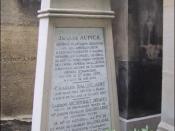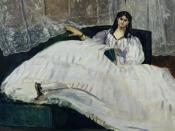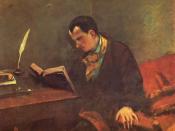Baudelaire was a 19th century French poet who desired to write poetry in prose form, often challenging other authors to do so (Benjamin 165). He finally took on this ambitious objective himself when he wrote the book Twenty Prose Poems. The book consists of poetry without rhythm or rhyme. This seems to fit Baudelaire's style almost perfectly because he often wrote controversial and unexplainable poetry. Many of the poems have an initial meaning, visible to the reader at first glance. However some poems serve a greater purpose. This extra meaning comes from difficult images Baudelaire carefully constructs. This image or idea of a greater purpose is also evident in "The Great Cat Massacre" by Robert Darnton. The cats being killed in the essay represent more than just that fact alone. It represents the lower class getting back at the upper class, and proving that the cat's life meant more to them than the people's lives in the working class.
Similarly, in Charles Baudelaire's poem, "Which is the True One?" a perplexing image is created. The poem's character says "to add emphasis to [his] refusal [he] struck the ground so violently with [his] foot that [his] leg sank knee-deep into the fresh soil, and like a wolf caught in a trap, [he] remain[s] attached, for ever perhaps, to the grave of the ideal" (Baudelaire 61). What is the reason for his refusal? Why is he furious? Why is his refusal so intense? Is he unable to free himself or just unwilling? He tells us: (with all upper case letters) "ONCE" he knew a girl, twice "It was [he] who buried her" and utters his furious reply "No! No! No!" three times, before he violently strikes the ground with his foot (Baudelaire 61). Baudelaire leaves the reader with this disturbing...


